Optimizing the Energy-Efficient Metro Train Timetable and Control Strategy in Off-Peak Hours with Uncertain Passenger Demands
Abstract
:1. Introduction
- ➢
- A more realistic model for the dynamic mathematical model of the metro train is formulated in this paper based on the assumption that a train is considered as a belt with uniformly-distributed mass instead of a mass point model [43].
- ➢
- The timetable optimization model formulated in this paper allows trains to drive as the optimal control strategy with a fixed running time of the section contributed by the reduction of dwelling time at the station, which has a significant reduction in energy consumption (more than 20%).
- ➢
- Compared with [5], when we construct the train movement model, both the track gradients and the curves are taken into account in order to describe train energy consumption more accurately.
2. Mathematical Formulations
- (1)
- In this manuscript, steady demand within only two periods is considered: peak and off-peak.
- (2)
- In the off-peak hours, there is no congestion effect, indicating that all passengers who are waiting on a specific station platform can board the train.
- (3)
- In the off-peak hours we studied, the train departure interval is a constant.
- (4)
- The train’s departure times at each station are equal to the ones of the initial timetable.
- (5)
- In this model, the motor efficiency is simplified.
2.1. Timetable Optimization Module
2.1.1. Passenger Characteristics
2.1.2. Dwelling Time Calculation
2.2. Train Operation Simulation Module
2.2.1. Optimal Train Control Strategies with Fixed Time
- (1)
- Generate a driving strategy of a time-saving pattern and the minimized running time of this section.
- (2)
- Calculate the margin time of the total section as the difference between the running time of the time-saving pattern and the one of the fixed time pattern.
- (3)
- Divide the section into several subsections by the changes of lines’ speed limits. Previous studies [5,18] have demonstrated that acceleration and coasting are both components of the energy-efficient strategy. Accordingly, the margin time should be allocated to deceleration subsections as much as possible.
- (4)
- Initialize the speed limit of each subsection, indicating that the speed limit shall reduce to a lower level from the original high one.
- (5)
- With the limit of the given running time and initial speed of this subsection, calculate a driving strategy and output the actual running time. If the actual running time satisfies the error request, turn to the next subsection.
- (6)
- Output the results, and end the simulation when all sections have been simulated.
2.2.2. Train Movement Simulation Models
2.2.3. Energy Consumption Calculation
3. Optimal Model and Solution Method
3.1. Optimal Model
3.2. Solution Method
- (1)
- Calculate the real-time dwelling time margin Tm for station i, ∀ i = 1, 2, …, I.
- (2)
- A simulation model is then run in section i for a train j with the fixed time margin calculated in (7), where the train control strategies can be obtained with the algorithm presented in Section 2.1.2.
- (3)
- Calculate the minimize energy consumption Ei,j by using the mass-belt train motion model and the force models according to the condition of section i.
- (4)
- The simulation process will be executed repeatedly until train j arrives at terminal station I.
4. Sensitivity Analysis of the Simulation
4.1. Sensitivity Analysis
4.1.1. The Curve Sensitivity Analysis
- (i)
- When the radius curve is larger than 500 m, the energy consumption is close to the same one of no radius curve.
- (ii)
- When the radius curve is smaller than 300 m, the energy consumption is larger.
4.1.2. The Gradient Sensitivity Analysis
4.1.3. The Length of Grade and Speed Limit Sensitivity Analysis
- (1)
- All curves of energy consumption can be divided into three sections: low speed section, middle speed section and high speed section.
- (2)
- Based on the 30‰ gradient, the middle sections are respectively 40–90 km/h, 40–80 km/h and 40–70 km/h for the lengths of 600, 400 and 200 m.
- (3)
- In each speed section, with the increase of speed, the energy consumption increases linearly.
4.2. Accuracy Analysis
5. Numerical Examples
5.1. A Case of One Single Section’s Energy Consumption
5.2. The Case of the Whole Line
5.3. A Real-World Case Study
6. Conclusions
Acknowledgments
Author Contributions
Conflicts of Interest
Abbreviations
| Passenger Flow | |
| λi(t) | The passenger arriving rate at station i and time t |
| κi,i’(t) | The passenger arriving amount at station i at time t with destination station i’ |
| Pi,j | Number of passengers waiting on the platform who board the train j at station i |
| Qi,j | Number of passengers alight the train j with trip destination i |
| Oi,j | Number of in-vehicle passengers of train j driving from station i to station i + 1 |
| γi,i’ | The ratio describing the passengers boarding the train j at station i who alighting at station i’ |
| DOC | The degree of crowdedness |
| Train Timetable | |
| a⁰i,j | The arrive time for a train j arriving at station i according to the timetable |
| d⁰ij | The departure time for a train j leaving station i according to the timetable |
| ai,j | The actual arrive time for a train j arriving at station i |
| di,j | The actual departure time for a train j leaving station i |
| T⁰D,i,j | The dwelling time of a train j at station i according to the timetable |
| TD,i,j | The actual dwelling time of a train j at station i |
| The minimum dwelling time for train j at station i | |
| TR,i,j | The running time of a train j at section i, which is defined as the one between the stations i and i + 1 |
| Train Control Strategies with Fixed-Time | |
| Tm | The dwelling time margin |
| Tb | The braking time from point A to point O |
| Tc | The coasting time from point A to point O |
| Tu | The uniform time from point C to point A |
| Tc-b | The coasting-braking time from point B to point O passes point X |
| Terror | The calculation error |
| Energy Consumption | |
| Tf | The traction force |
| t(v) | The specific (per mass unit) traction force |
| Rf | The resistance force |
| r(v) | The specific (per mass unit) basic running resistance |
| r0, r1, r2 | The coefficients of basic running resistance |
| w(x) | The specific (per mass unit) additional resistance |
| wg(x) | The unit gradient resistance |
| wr(x) | The unit curvature resistance |
| wt | The unit tunnel resistance |
| M | The train traction weight |
| Mt | The mass of the train |
| Mp | The mass of loading passengers |
| ρ | The mass per unit length |
| g(x − s) | The gradient of position (x − s) |
| S | The train length |
| α | The angle of the curve |
| Lr(x) | The length of the curve |
| R | The radius of the curve |
| Bf | The braking force |
| b(v) | The specific (per mass unit) braking force |
| c | The specific force |
| vk | The initial speeds of k-th time step |
| vk+1 | The initial speeds of (k + 1)-th time step |
| Vmax | The limit speed |
| ak | The accelerated speed at k-th time step |
| σ | One time step |
| lk | The positions of k-th time step |
| lk+1 | The positions of (k + 1)-th time step |
| Ek | The accumulative energy consumption of k-th time step |
| Ek+1 | The accumulative energy consumption of (k + 1)-th time step |
| ek | The energy consumption of k-th time step |
| Etotal | The total energy consumption |
References
- Nag, B.; Pal, M.N. Optimal design of timetables to maximize schedule reliability & minimize energy consumption, rolling stock and crew deployment. In Proceedings of the 2nd UIC (International Union of Railways) Energy Efficiency Conference, Paris, France, 2–4 February 2004. [Google Scholar]
- Nasri, A.; Moghadam, M.F.; Mokhtari, H. Timetable optimization for maximum usage of regenerative energy of braking in electrical railway systems. In Proceedings of the International Symposium on Power Electronics Electrical Drives Automation and Motion, Pisa, Italy, 14–16 June 2010; pp. 1218–1221. [Google Scholar]
- Peňa-Alcaraz, M.; Fernández, A.; Cucala, A.P.; Ramos, A.; Pecharromán, R.R. Optimal underground timetable design based on power flow for maximizing the use of regenerative-braking energy. Proc. Mech. Eng. Part F J. Rail Rapid Transit 2012, 226, 397–408. [Google Scholar] [CrossRef]
- Yang, X.; Ning, B.; Li, X.; Tang, T. A two-objective timetable optimization model in subway systems. IEEE Trans. Intell. Transp. Syst. 2014, 15, 1913–1921. [Google Scholar] [CrossRef]
- Gong, C.; Zhang, S.; Zhang, F.; Jiang, J.; Wang, X. An integrated energy-efficient operation methodology for metro systems based on a real case of shanghai metro line one. Energies 2014, 7, 7305–7329. [Google Scholar] [CrossRef]
- Lin, F.; Liu, S.; Yang, Z.; Zhao, Y.; Yang, Z.; Sun, H. Multi-train energy saving for maximum usage of regenerative energy by dwell time optimization in urban rail transit using genetic algorithm. Energies 2016, 9, 208. [Google Scholar] [CrossRef]
- Yang, X.; Li, X.; Gao, Z.; Wang, H.; Tang, T. A cooperative scheduling model for timetable optimization in subway systems. IEEE Trans. Intell. Transp. Syst. 2013, 14, 438–447. [Google Scholar] [CrossRef]
- Erofeyev, E. Calculation of Optimum Train Control Using Dynamic Programming Method; Moscow Railway Engineering Institute: Moscow, Russia, 1967; Volume 811, pp. 16–30. [Google Scholar]
- Ichikawa, K. Application of optimization theory for bounded state variable problems to the operation of train. Bull. JSME 1968, 11, 857–865. [Google Scholar] [CrossRef]
- Figuera, J. Automatic optimal control of trains with frequent stops. Dyna 1970, 45, 263–269. [Google Scholar]
- Kokotovic, P.; Singh, G. Minimum-energy control of a traction motor. IEEE Trans. Autom. Control 1972, 17, 92–95. [Google Scholar] [CrossRef]
- Hoang, H.H.; Polis, M.P.; Haurie, A. Reducing energy consumption through trajectory optimization for a Metero network. IEEE Trans. Autom. Control 1975, 20, 590–594. [Google Scholar] [CrossRef]
- Lee, G.H.; Milroy, I.P.; Tyler, A. Application of pontryagin’s maximum principle to the semi-automatic control of rail vehicles. In Proceedings of the Second Conference on Control Engineering, Newcastle, UK, 25–27 August 1982. [Google Scholar]
- Cheng, J.X.; Howlett, P.G. Application of critical velocities to the minimization of fuel consumption in the control of trains. Automatic 1992, 28, 165–169. [Google Scholar]
- Howlett, P.G.; Pudney, P.J. Energy-Efficient Train Control; Springer Press: London, UK, 1995. [Google Scholar]
- Howlett, P.G. Optimal strategies for the control of a train. Automatica 1996, 32, 519–532. [Google Scholar] [CrossRef]
- Howlett, P.G.; Cheng, J.X. Optimal driving strategies for a train on a track with continuously varying gradient. J. Aust. Math. Soc. Ser. B 1997, 38, 388–410. [Google Scholar] [CrossRef]
- Khmelnitsky, E. On an optimal control problem of train operation. IEEE Trans. Autom. Control 2000, 45, 1257–1266. [Google Scholar] [CrossRef]
- Howlett, P.G.; Pudney, P.J.; Xuan, V. Local energy minimization in optimal train control. Automatica 2009, 45, 2692–2698. [Google Scholar] [CrossRef]
- Ning, B.; Xun, J.; Gao, S.G.; Zhang, L.Y. An integrated control model for headway regulation and energy-saving in urban rail transit. IEEE Trans. Intell. Transp. Syst. 2015, 16, 1469–1478. [Google Scholar] [CrossRef]
- Huang, Y.; Ma, X.; Su, S.; Tang, T. Optimization of train operation in multiple interstations with multi-population genetic algorithm. Energies 2015, 8, 14311–14329. [Google Scholar] [CrossRef]
- Su, S.; Li, X.; Tang, T.; Gao, Z. A subway train timetable optimization approach based on energy-efficient operation strategy. IEEE Trans. Intell. Transp. Syst. 2013, 14, 883–893. [Google Scholar] [CrossRef]
- Kim, D.N.; Schonfeld, P.M. Benefits of dipped vertical alignments for rail transit routes. J. Transp. Eng. 1997, 123, 20–27. [Google Scholar] [CrossRef]
- Kim, K.; Chien, S.I. Simulation-based analysis of train controls under various track alignment. J. Transp. Eng. 2010, 136, 937–948. [Google Scholar] [CrossRef]
- Kim, K.; Chien, S.I. Optimal train operation for minimum energy consumption considering track alignment, speed limit, and schedule adherence. J. Transp. Eng. 2011, 137, 665–674. [Google Scholar] [CrossRef]
- Kim, M.; Schonfeld, P.; Kim, E. Simulation-based rail transit optimization model. Transp. Res. Rec. 2013, 2374, 143–153. [Google Scholar] [CrossRef]
- Huang, Y.; Yang, L.; Tang, T.; Cao, F.; Gao, Z. Saving energy and improving service quality: Bicriteria train scheduling in urban rail transit systems. IEEE Trans. Intell. Transp. Syst. 2016, 17, 3364–3379. [Google Scholar] [CrossRef]
- Lu, S.; Hillmansen, S.; Ho, T.K.; Roberts, C. Single-train trajectory optimization. IEEE Trans. Intell. Transp. Syst. 2013, 14, 743–750. [Google Scholar] [CrossRef]
- Carvajal-Carreño, W.; Cucala, A.P.; Fernández-Cardador, A. Optimal design of energy-efficient ATO CBTC driving for metro lines based on NSGA-II with fuzzy parameters. Eng. Appl. Artif. Intell. 2014, 36, 164–177. [Google Scholar] [CrossRef]
- González-Gil, A.; Palacin, R.; Batty, P.; Powell, J.P. A systems approach to reduce urban rail energy consumption. Energy Convers. Manag. 2014, 80, 509–524. [Google Scholar] [CrossRef]
- Sicre, C.; Cucala, A.P.; Fernández-Cardador, A. Real time regulation of efficient driving of high speed trains based on a genetic algorithm and a fuzzy model of manual driving. Eng. Appl. Artif. Intell. 2014, 29, 79–92. [Google Scholar] [CrossRef]
- Ding, Y.; Liu, H.D.; Bai, Y.; Zhou, F.M. A two-level optimization model and algorithm for energy-efficient urban train operation. J. Transp. Syst. Eng. Inf. Technol. 2011, 11, 96–101. [Google Scholar] [CrossRef]
- Cucala, A.P.; Fernández-Cardador, A.; Sicre, C.; Domínguez, M. Fuzzy optimal schedule of high speed train operation to minimize energy consumption with uncertain delays and driver’s behavioral response. Eng. Appl. Artif. Intell. 2012, 25, 1548–1557. [Google Scholar] [CrossRef]
- Li, X.; Lo, H.K. An energy-efficient scheduling and speed control approach for metro rail operations. Transp. Res. Part B Methodol. 2014, 64, 73–89. [Google Scholar] [CrossRef]
- Li, X.; Lo, H.K. Energy minimization in dynamic train scheduling and control for metro rail operations. Transp. Res. Part B Methodol. 2014, 70, 269–284. [Google Scholar] [CrossRef]
- Chapter 3 Operations Concepts. In Transit Capacity and Quality of Service Manual, 3rd ed.; Transportation Research Board: Washington, DC, USA, 2013; pp. 23–27.
- Harris, N.G.; Anderson, R.J. An international comparison of urban rail boarding and alighting rates. Proc. Mech. Eng. Part F J. Rail Rapid Transit 2007, 221, 521–526. [Google Scholar] [CrossRef]
- Lam, W.H.K.; Cheung, C.Y.; Poon, Y.F. A study of train dwelling time at the Hong Kong mass transit railway system. J. Adv. Transp. 1998, 32, 285–295. [Google Scholar] [CrossRef]
- Puong, A. Dwell Time Model and Analysis for the MBTA Red Line; Massachusetts Institute of Technology Open Course Ware porject: Cambridge, MA, USA, 2000; pp. 1–10. [Google Scholar]
- San, H.P.; Masirin, M.I.M. Train dwell time models for rail passenger service. MATEC Web Conf. 2016, 47, 03005. [Google Scholar] [CrossRef]
- Alvarez, A.; Merchan, F.; Poyo, F.; George, R. A fuzzy logic-based approach for estimation of dwelling times of panama metro stations. Entropy 2015, 17, 2688–2705. [Google Scholar] [CrossRef]
- Kim, J.; Kim, M.S.; Hong, J.S.; Kim, T. Development of a boarding and alighting time model for the urban rail transit in a megacity. In Proceedings of the 21st International Conference on Urban Transport and the Environment, València, Spain, 2–4 June 2015. [Google Scholar]
- Su, S.; Tang, T.; Wang, Y. Evaluation of strategies to reducing traction energy consumption of metro systems using an optimal train control simulation model. Energies 2016, 9, 105. [Google Scholar] [CrossRef]
- Niu, H.; Zhou, X. Optimizing urban rail timetable under time-dependent demand and oversaturated conditions. Transp. Res. Part C Emerg. Technol. 2013, 36, 212–230. [Google Scholar] [CrossRef]
- Barrena, E.; Canca, D.; Coelho, L.C.; Laporte, G. Single-line rail transit timetabling under dynamic passenger demand. Transp. Res. Part B Methodol. 2014, 70, 134–150. [Google Scholar] [CrossRef]
- Yin, J.; Tang, T.; Yang, L.; Gao, Z.; Ran, B. Energy-efficient metro train rescheduling with uncertain time-variant passenger demands: An approximate dynamic programming approach. Transp. Res. Part B Methodol. 2016, 91, 178–210. [Google Scholar] [CrossRef]
- Xu, X.; Li, K.; Li, X. A multi-objective subway timetable optimization approach with minimum passenger time and energy consumption. J. Adv. Transp. 2015, 50, 69–95. [Google Scholar] [CrossRef]
- Feng, J.; Mao, B.; Chen, Z.; Bai, Y.; Li, M. A departure time choice for morning commute considering train capacity of a rail transit line. Adv. Mech. Eng. 2013, 2013, 1–7. [Google Scholar] [CrossRef]
- Wirasinghe, S.C.; Szplett, D. An investigation of passenger interchange and train standing time at LRT stations: (ii) Estimation of standing time. J. Adv. Transp. 1984, 18, 13–24. [Google Scholar] [CrossRef]
- Jung, Y.-S.; Kim, M.-H. The research on the adequacy of urban trainset—Focus the Jung-ang line for urban. In Proceedings of the Conference of the Korean Society for Railway, Jeju, Korea, 17–19 May 2007. [Google Scholar]
- Feng, X.S.; Mao, B.H.; Feng, X.J.; Feng, J. Study on the maximum operation speeds of metro trains for energy saving as well as transport efficiency improvement. Energy 2011, 36, 6577–6582. [Google Scholar] [CrossRef]
- Ho, T.K.; Mao, B.H.; Yuan, Z.Z.; Liu, H.D.; Fung, Y.F. Computer simulation and modeling in railway applications. Comput. Phys. Commun. 2002, 143, 1–10. [Google Scholar] [CrossRef]
- Howlett, P.G. The optimal control of a train. Ann. Oper. Res. 2000, 98, 65–87. [Google Scholar] [CrossRef]
- Liu, R.; Golovicher, I.M. Energy-efficient operation of rail vehicles. Transp. Res. Part A Policy Pract. 2003, 37, 917–931. [Google Scholar] [CrossRef]
- Hansen, I.A.; Pachl, J. Railway Timetable & Traffic: Analysis, Modeling, Simulation; Eurailpress: Hamburg, Germany, 2008. [Google Scholar]
- Soh, H.; Lim, S.; Zhang, T.; Fu, X.; Lee, G.K.K.; Hung, T.G.G.; Di, P.; Prakasam, S.; Wong, L. Weighted complex network analysis of travel routes on the Singapore public transportation system. Physica A 2010, 389, 5852–5863. [Google Scholar] [CrossRef]
- Feng, J.; Li, X.; Mao, B.; Xu, Q.; Bai, Y. Weighted complex network analysis of the different patterns of metro traffic flows on weekday and weekend. Discret. Dyn. Nat. Soc. 2016, 2016. [Google Scholar] [CrossRef]

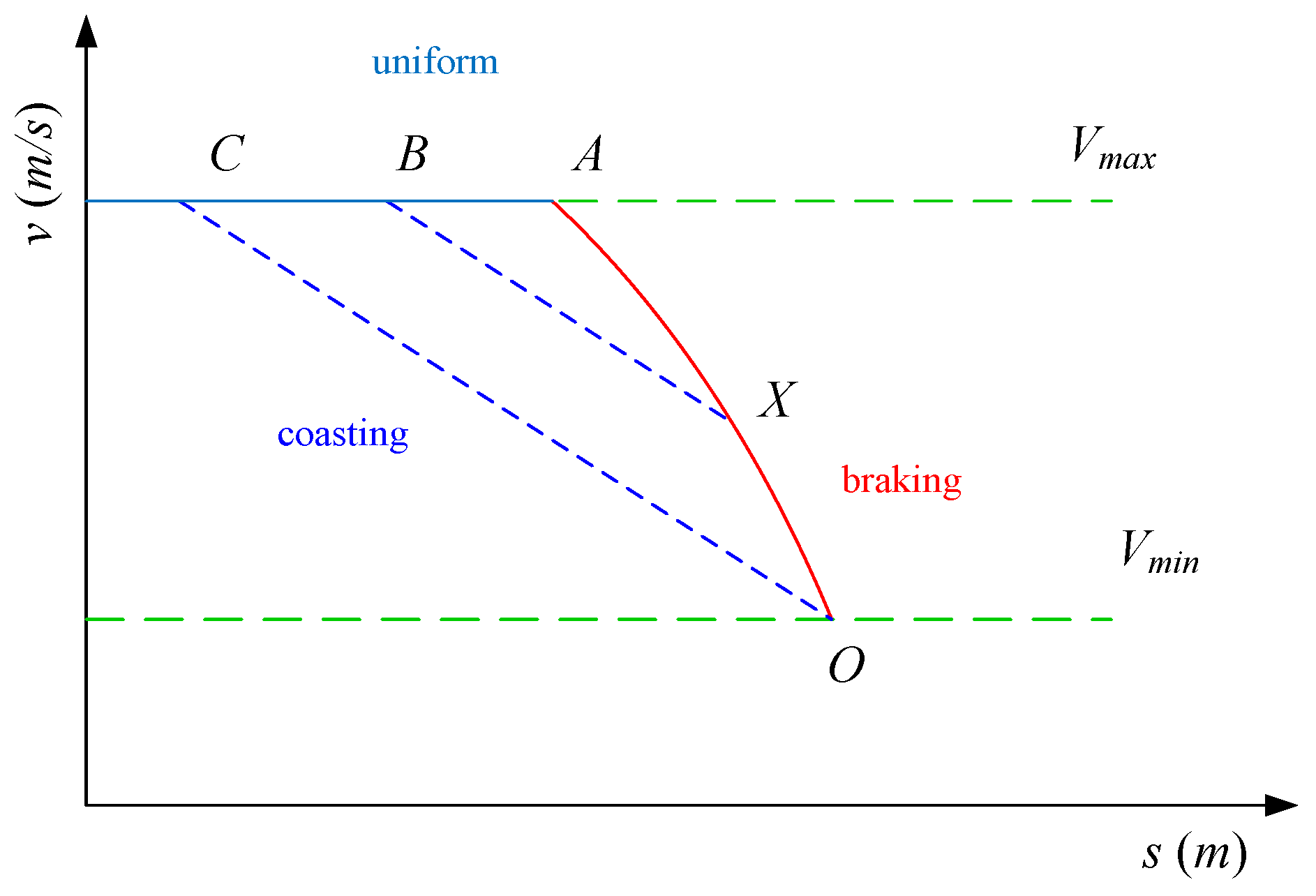
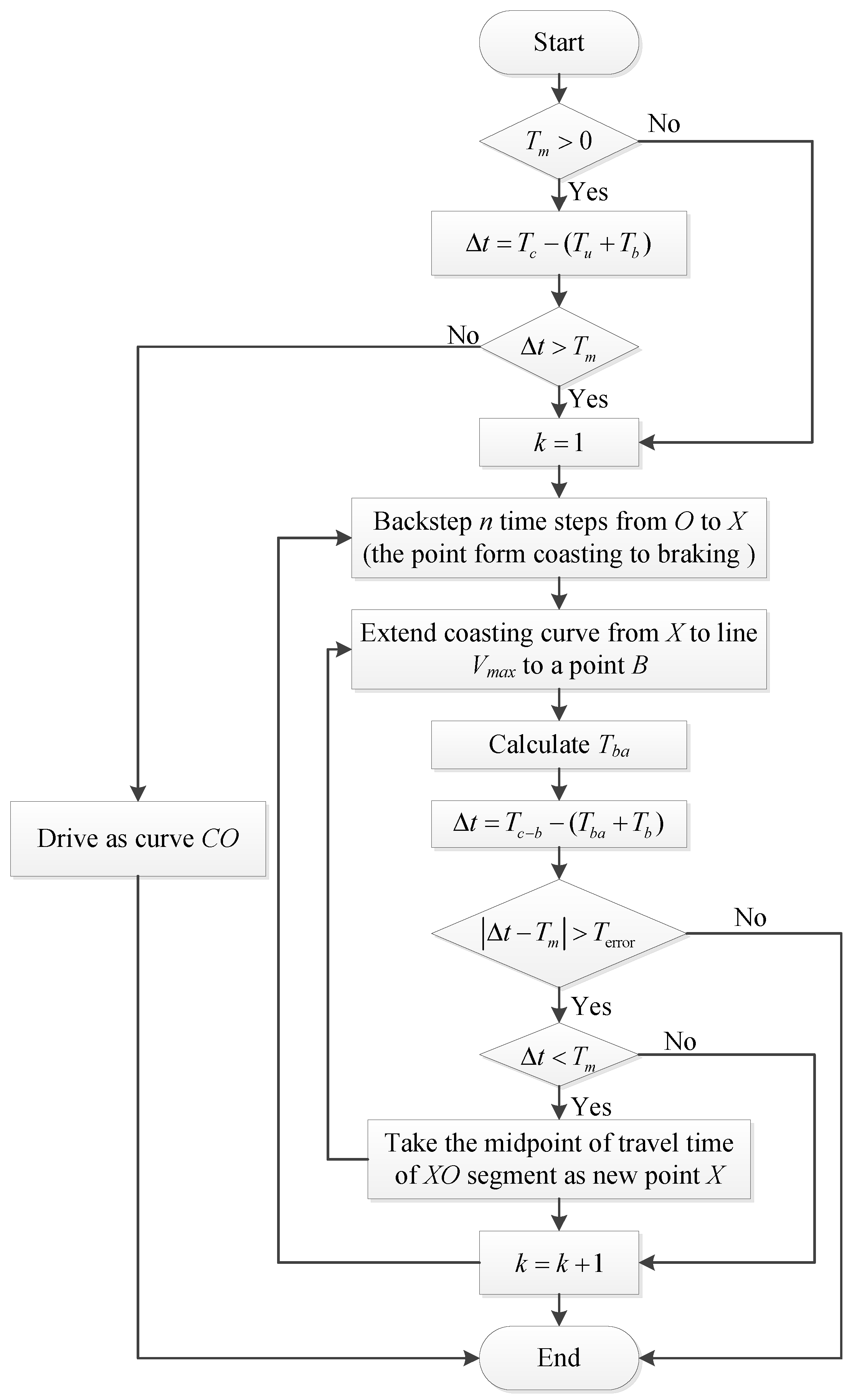
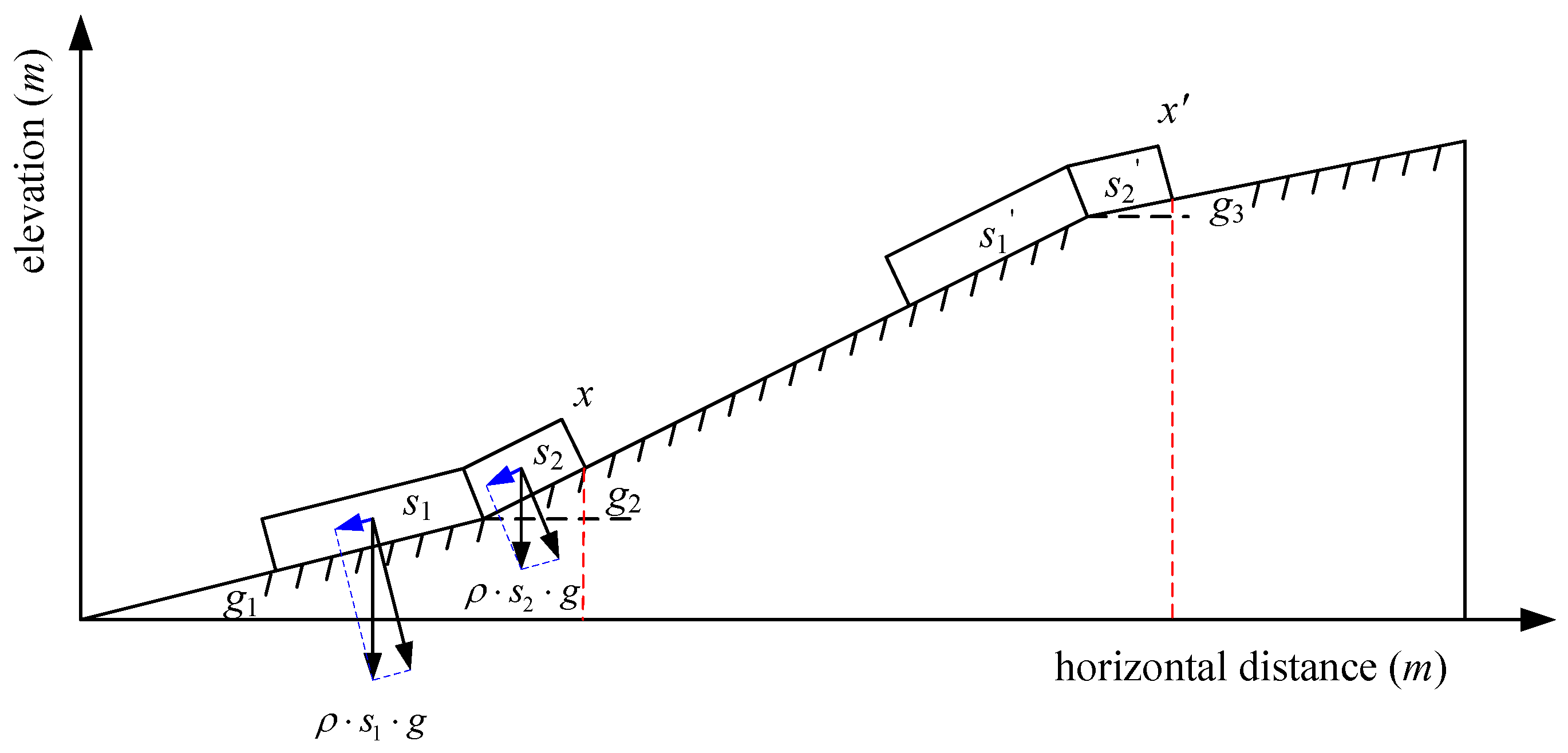
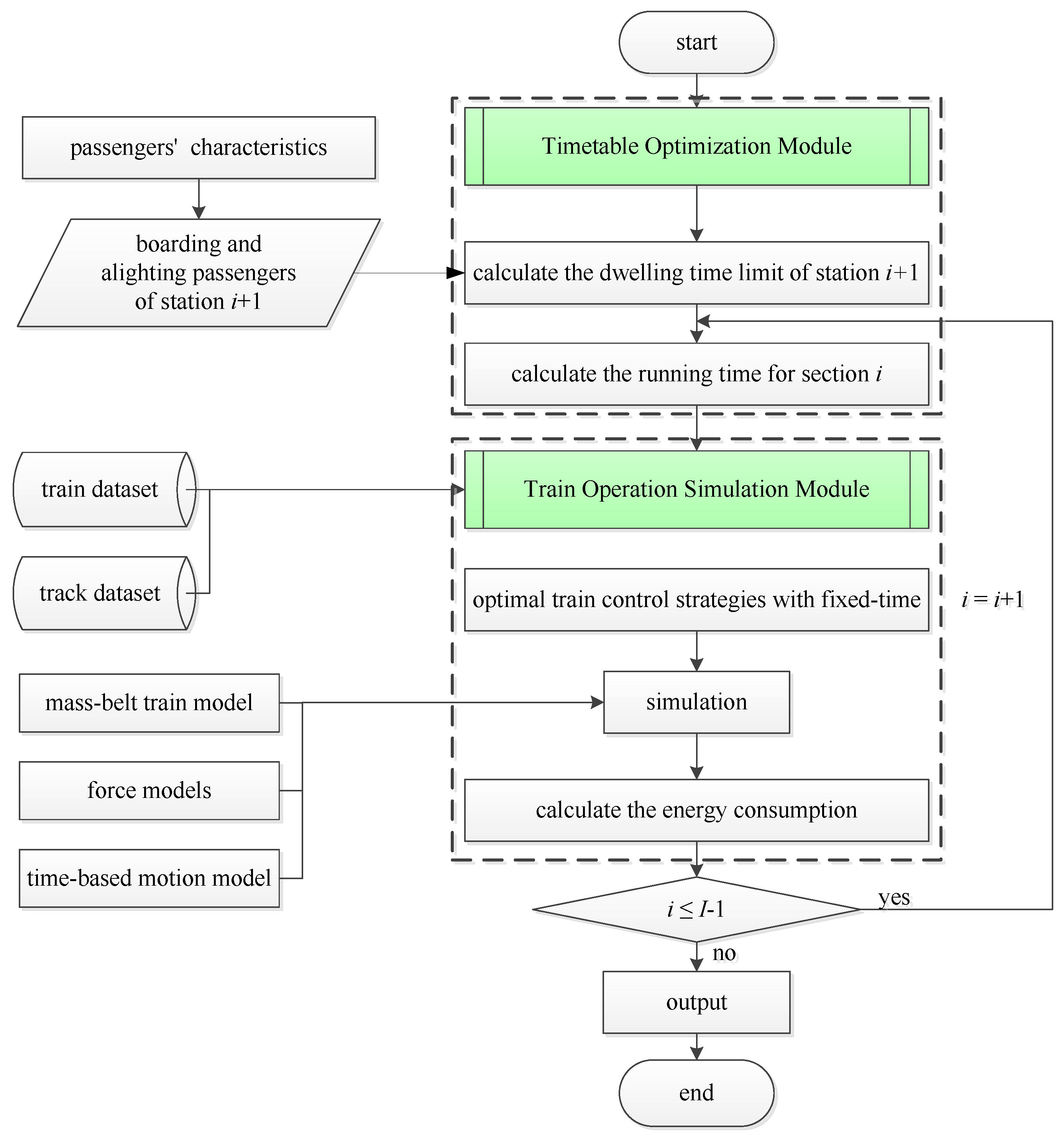
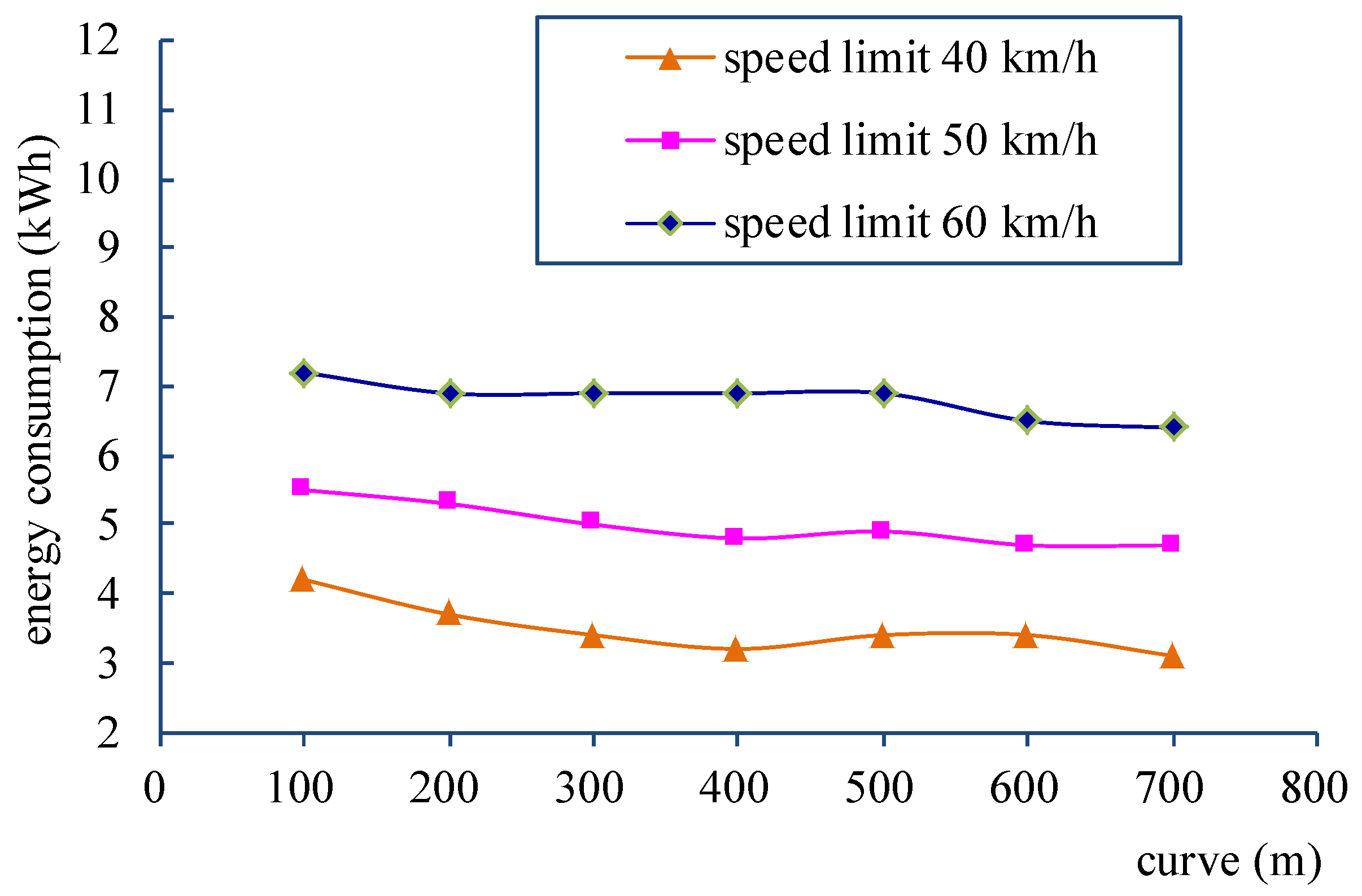

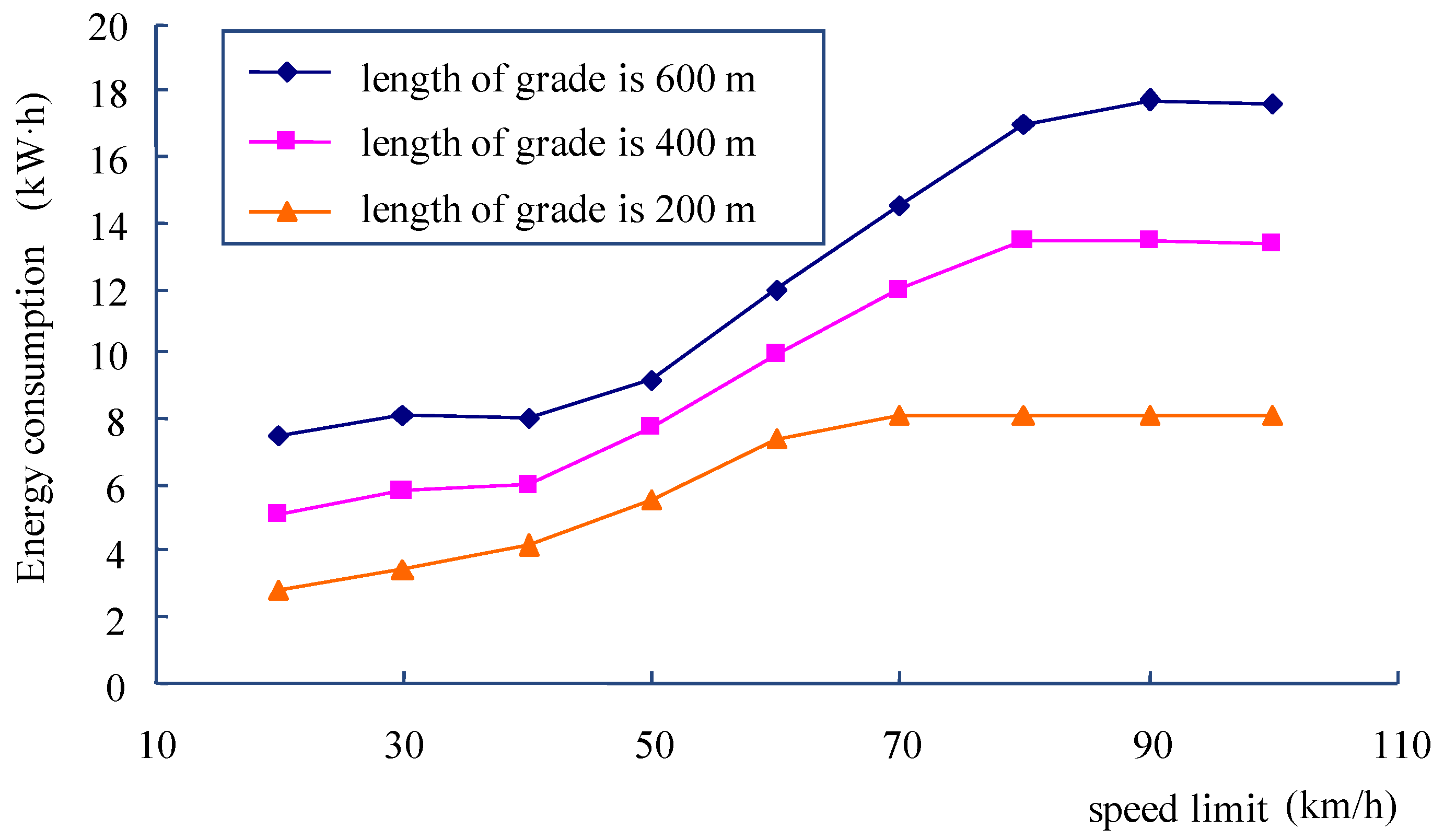

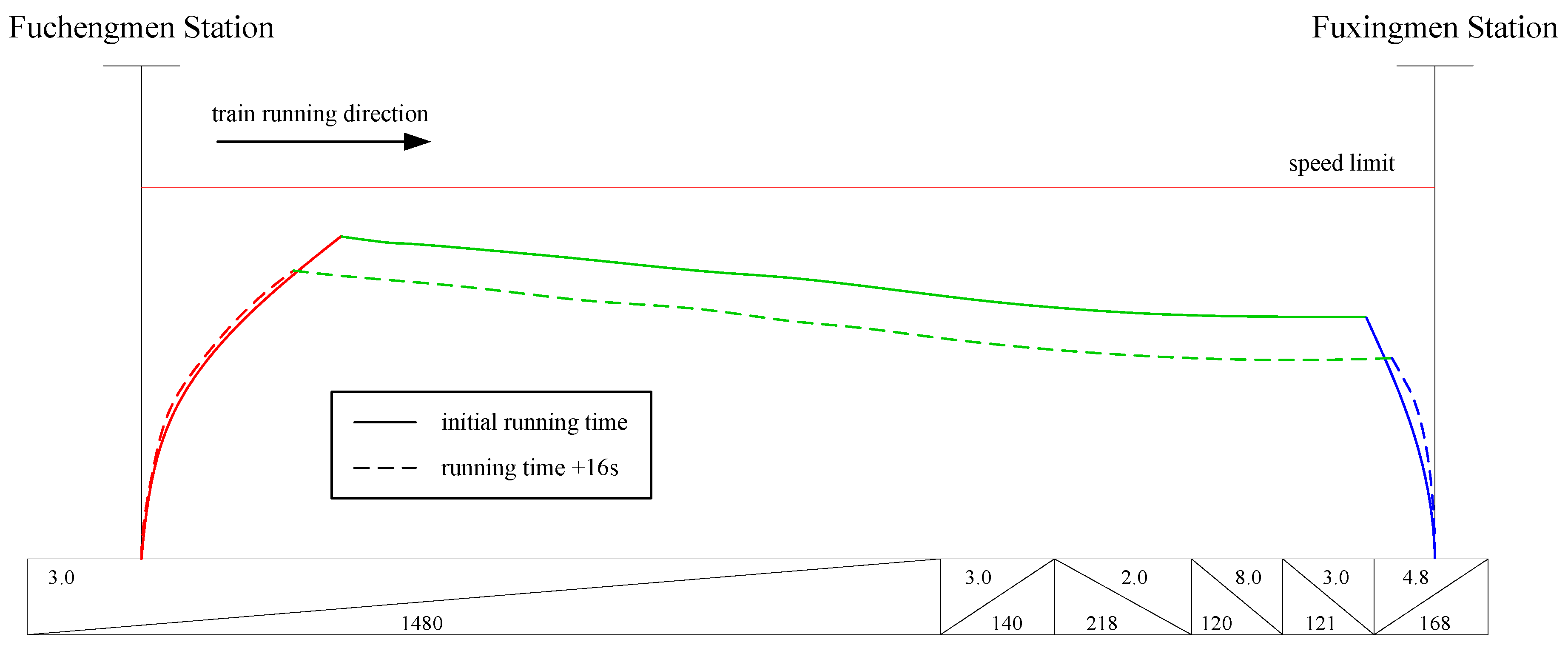
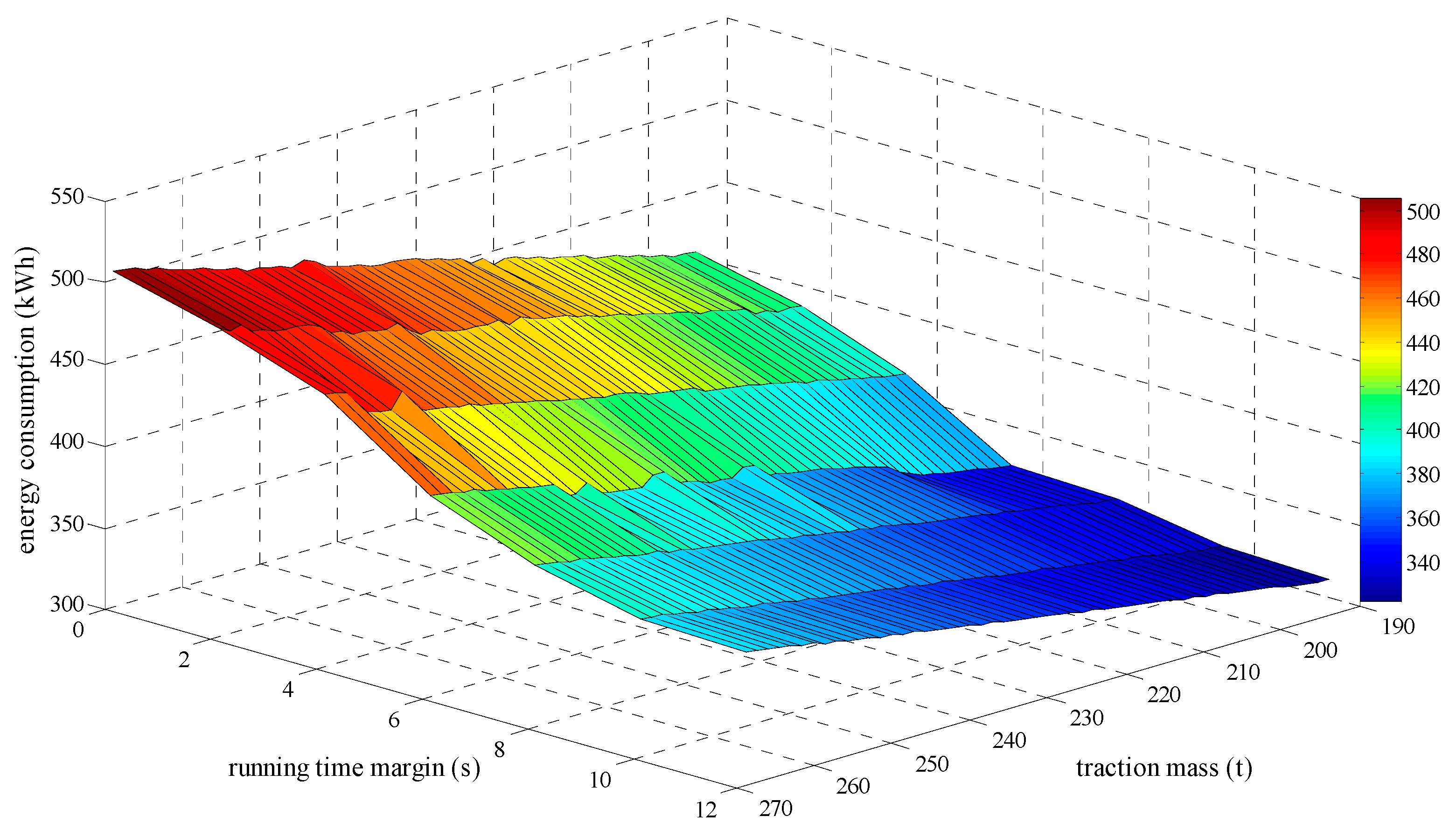
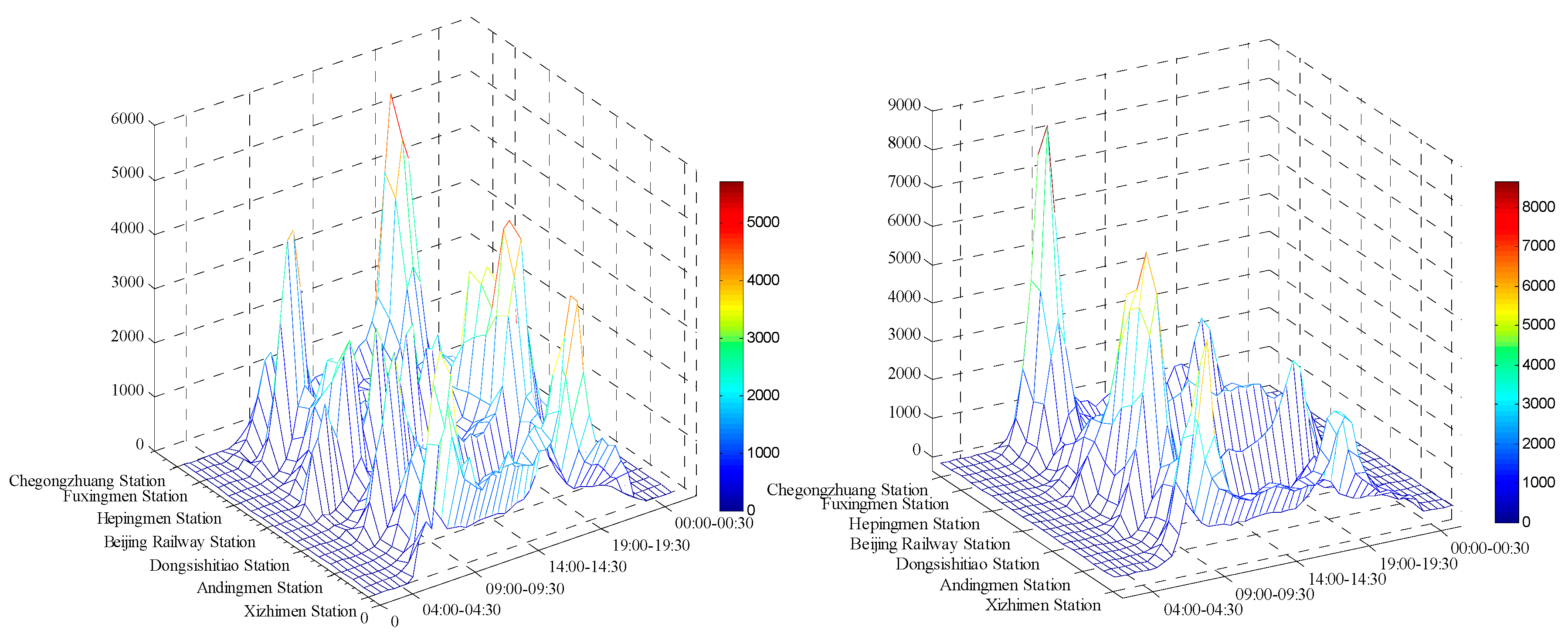
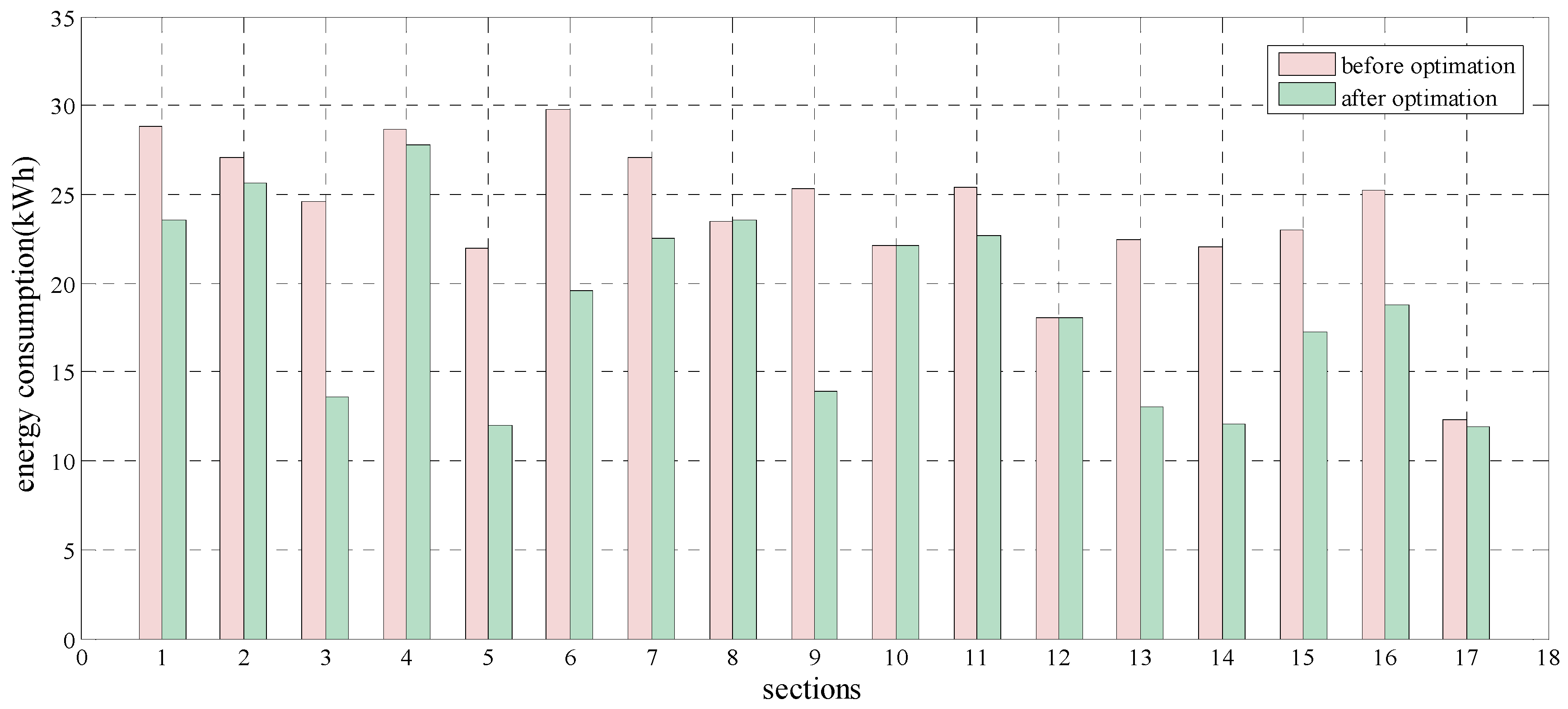
| The Kinds of Energy Consumption | Measurement | Simulation | ε | δ | |
|---|---|---|---|---|---|
| AW0 | Traction energy consumption | 375 | 361.64 | 13.36 | 3.56% |
| 100% regenerative braking energy | 206 | 215.50 | 9.50 | 4.61% | |
| AW2 | Traction energy consumption | 514 | 530.35 | 16.35 | 3.18% |
| 100% regenerative braking energy | 305 | 308.04 | 3.04 | 0.99% | |
| AW3 | Traction energy consumption | 549 | 566.10 | 17.10 | 3.11% |
| 100% regenerative braking energy | 335 | 331.08 | 3.92 | 1.17% | |
| Segment | Grade (‰) | Length (m) |
|---|---|---|
| 1 | 3.0 | 1207.7 |
| 2 | 3.0 | 140.3 |
| 3 | −2.0 | 218.0 |
| 4 | −8.0 | 120.0 |
| 5 | −3.0 | 121.0 |
| 6 | 4.8 | 25.0 |
| Total | - | 1832.0 |
| Fixed Running Time (s) | 137 | 139 | 141 | 143 | 145 | 147 | 149 | 151 | 153 |
| Energy consumption (kWh) | 22.99 | 21.63 | 21.58 | 21.45 | 21.29 | 21.19 | 21.15 | 20.97 | 20.92 |
| Optimal rate | - | 5.9% | 0.2% | 0.6% | 0.7% | 0.5% | 0.2% | 0.9% | 0.2% |
| Traction Mass (t) | 194.00 | 195.44 | 196.88 | 198.32 | 199.76 | 201.20 | 202.64 | 204.08 | 205.52 |
| Energy consumption (kWh) | 324.31 | 325.05 | 325.71 | 327.15 | 327.92 | 329.85 | 330.76 | 332.23 | 333.17 |
| Traction mass (t) | 206.96 | 208.40 | 209.84 | 211.28 | 212.72 | 214.16 | 215.60 | 217.04 | 218.48 |
| Energy consumption (kWh) | 333.79 | 335.55 | 336.28 | 337.73 | 338.41 | 339.82 | 340.76 | 342.4 | 343.08 |
| Traction mass (t) | 219.92 | 221.36 | 222.80 | 224.24 | 225.68 | 227.12 | 228.56 | 230.00 | 231.44 |
| Energy consumption (kWh) | 343.99 | 345.35 | 346.46 | 348.15 | 348.86 | 350.13 | 351.07 | 352.83 | 353.43 |
| Traction mass (t) | 232.88 | 234.32 | 235.76 | 237.20 | 238.64 | 240.08 | 241.52 | 242.96 | 244.40 |
| Energy consumption (kWh) | 354.24 | 356.09 | 356.79 | 358.51 | 359.17 | 360.83 | 361.54 | 362.59 | 363.97 |
| Traction mass (t) | 245.84 | 247.28 | 248.72 | 250.16 | 251.60 | 253.04 | 254.48 | 255.92 | 257.36 |
| Energy consumption (kWh) | 364.88 | 366.5 | 367.15 | 368.85 | 369.43 | 371.31 | 371.98 | 372.93 | 374.83 |
| Traction mass (t) | 258.80 | 260.24 | 261.68 | 263.12 | 264.56 | 266.00 | 267.44 | 268.88 | |
| Energy consumption (kWh) | 375.61 | 377.71 | 378.31 | 380.27 | 380.96 | 382.56 | 383.25 | 384.18 |
| Section | Length (m) * | Running Time (s) | Dwelling Time (s) | Section Passengers |
|---|---|---|---|---|
| Jianguomen Station–Chaoyangmen Station | 1763 | 123 | 45 | 166,945 |
| Chaoyangmen Station–Dongsishitiao Station | 1027 | 88 | 30 | 157,873 |
| Dongsishitiao Station–Dongzhimen Station | 824 | 78 | 50 | 148,313 |
| Dongzhimen Station–Lama Temple Station | 2228 | 174 | 45 | 114,565 |
| Lama Temple Station–Andingmen Station | 794 | 74 | 30 | 143,292 |
| Andingmen Station–Guloudajie Station | 1237 | 98 | 50 | 145,613 |
| Guloudajie Station–Jishuitan Station | 1766 | 129 | 50 | 160,098 |
| Jishuitan Station–Xizhimen Station | 1899 | 166 | 60 | 161,824 |
| Xizhimen Station–Chegongzhuang Station | 909 | 87 | 45 | 156,004 |
| Chegongzhuang Station–Fuchengmen Station | 960 | 85 | 30 | 159,932 |
| Fuchengmen Station–Fuxingmen Station | 1832 | 137 | 50 | 157,867 |
| Fuxingmen Station–Changchunjie Station | 1234 | 115 | 30 | 109,896 |
| Changchunjie Station–Xuanwumen Station | 929 | 85 | 30 | 110,013 |
| Xuanwumen Station–Hepingmen Station | 851 | 82 | 30 | 154,568 |
| Hepingmen Station–Qianmen Station | 1171 | 95 | 30 | 155,703 |
| Qianmen Station–Chongwenmen Station | 1634 | 123 | 45 | 157,306 |
| Chongwenmen Station–Beijing Railway Station | 1023 | 112 | 60 | 136,104 |
| Beijing Railway Station–Jianguomen Station | 945 | 101 | 60 | 133,743 |
© 2017 by the authors. Licensee MDPI, Basel, Switzerland. This article is an open access article distributed under the terms and conditions of the Creative Commons Attribution (CC BY) license (http://creativecommons.org/licenses/by/4.0/).
Share and Cite
Feng, J.; Li, X.; Liu, H.; Gao, X.; Mao, B. Optimizing the Energy-Efficient Metro Train Timetable and Control Strategy in Off-Peak Hours with Uncertain Passenger Demands. Energies 2017, 10, 436. https://doi.org/10.3390/en10040436
Feng J, Li X, Liu H, Gao X, Mao B. Optimizing the Energy-Efficient Metro Train Timetable and Control Strategy in Off-Peak Hours with Uncertain Passenger Demands. Energies. 2017; 10(4):436. https://doi.org/10.3390/en10040436
Chicago/Turabian StyleFeng, Jia, Xiamiao Li, Haidong Liu, Xing Gao, and Baohua Mao. 2017. "Optimizing the Energy-Efficient Metro Train Timetable and Control Strategy in Off-Peak Hours with Uncertain Passenger Demands" Energies 10, no. 4: 436. https://doi.org/10.3390/en10040436
APA StyleFeng, J., Li, X., Liu, H., Gao, X., & Mao, B. (2017). Optimizing the Energy-Efficient Metro Train Timetable and Control Strategy in Off-Peak Hours with Uncertain Passenger Demands. Energies, 10(4), 436. https://doi.org/10.3390/en10040436






